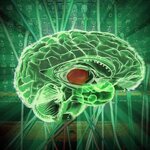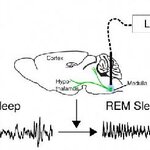Neuroscience

Autism is a group of complex brain developmental disorders characterized by impairments in social interaction, communication, and stereotypical and repetitive behaviors. The diagnosed incidence is estimated to be one in 68 children and effective interventions remain limited.
Behavioral therapies can improve social, emotional and behavioral impairments but these are typically time consuming (40 hours per week), remain costly and show mixed outcomes. There is currently no medical treatment for these problems.
A five week treatment with the synthetic hormone oxytocin significantly improved…

The hormone oxytocin, which has been associated with interpersonal bonding, may enhance the pleasure of social interactions by stimulating production of marijuana-like neurotransmitters in the brain, according to a new study.
The research is the first to link oxytocin - dubbed the "love hormone" by psychologists - and anandamide, which has similarly been called the "bliss molecule" for its role in activating cannabinoid receptors in brain cells, to heighten motivation and happiness.
To investigate the role of anandamide in social contact, University of California, Irvine's Daniele…

Our ability to learn, move, and sense our world comes from the neurons in our brain. The information moves through our brain between neurons that are linked together by tens of trillions of tiny structures called synapses.
Although tiny, synapses are not simple and must be precisely organized to function properly. Indeed, diseases like autism and Alzheimer's are increasingly linked to defects in the organization and number of these tiny structures. Now researchers at Thomas Jefferson University have found a new way in which synapses organization is controlled, which could eventually lead to…

Researchers say they have added to evidence that a shell-shaped region in the center of the mammalian brain, known as the thalamic reticular nucleus or TRN, is likely responsible for the ability to routinely and seamlessly multitask.
The process, they suggest, is done by individual TRN neurons that act like a "switchboard," continuously filtering sensory information and shifting more or less attention onto one sense -- like sight -- while relatively blocking out distracting information from other senses, including sound.
In their research in mice, the investigators showed that TRN…

At the flip of a switch, neuroscientists can send a sleeping mouse into dreamland.
The researchers did it by inserting an optogenetic switch into a group of nerve cells located in the ancient part of the brain called the medulla, allowing them to activate or inactivate the neurons with laser light.
When the neurons were activated, sleeping mice entered REM sleep within seconds. REM sleep, characterized by rapid eye movements, is the dream state in mammals accompanied by activation of the cortex and total paralysis of the skeletal muscles, presumably so that we don't act out the dreams…

A new study of newborns treated with hypothermia for hypoxic-ischemic encephalopathy (HIE) - a condition that occurs when the brain is deprived of an adequate oxygen supply - confirms its neuroprotective effects on the brain.
Therapeutic hypothermia or targeted cooling of the brain is the first therapy for neuroprotection in neonates with HIE. Without treatment, these babies often develop cerebral palsy or other severe complications. World-wide, nearly one million babies will die and another million will be left with disabilities.
"There is more that we can do," said the study's first author…

Antipsychotic drugs are initiated in patients with Alzheimer's disease (AD) more frequently than in the general population - already 2-3 years before the Alzheimer's diagnosis, according to a new study from the University of Eastern Finland. Most commonly, antipsychotics were initiated during the six months following the Alzheimer's diagnosis; however, the incidence of new antipsychotic users was high also later on.
The study analyzed the incidence of antipsychotic use eight years before and four years after the Alzheimer's diagnosis. During the follow-up, one third of the persons with…

Washington, DC--When a pregnant woman has gestational diabetes, her unborn child tends to react more slowly to sounds after the mother consumes sugary foods or drinks compared to the offspring of a woman who does not have the condition, according to a new study published in the Endocrine Society's Journal of Clinical Endocrinology&Metabolism.
Gestational diabetes is a form of diabetes that can develop during pregnancy. When it occurs, the levels of sugar in the pregnant woman's blood are higher than normal. For every 1,000 American women who are pregnant, as many as 92 women develop…

A pair of neurons that cause males to remember and seek sex even at the expense of food. These neurons, which are male-specific, are required for sex-based differences in learning, suggesting that sex differences in cognitive abilities can be genetically hardwired.
The study by UCL (UK) and Albert Einstein College of Medicine (USA), published today in Nature and funded by the Wellcome Trust, NIH, Marie Curie, and the G. Harold&Leila Y. Mathers Charitable Foundation, shows a direct link between contrasting behavior of male and female worms and differences in brain development and…

The cognitive skills used to learn how to ride a bike may be the key to a more accurate understanding of developmental dyslexia. And, they may lead to improved interventions.
Carnegie Mellon University scientists investigated how procedural learning - how we acquire skills and habits such as riding a bike - impacts how individuals with dyslexia learn speech sound categories. Published in Cortex, Lori Holt and Yafit Gabay found for the first time that learning complex auditory categories through procedural learning is impaired in dyslexia. This means that difficulty processing speech may be an…